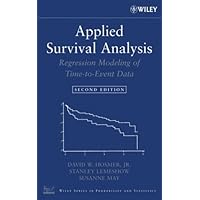
Average Reviews:

(More customer reviews)The authors provide a really nice, non-technical survey of the landscape for Cox Proportional Hazards models. A nice aspect of their treatment is the care they take to reference all highly technical texts and journal articles. For example, if you'd like to find out more about goodness-of-fit tests for survival models, the authors provide ample references to the Counting Process Theory of Martingale Residuals.
The first chapter discusses the basic characteristics of survival data, including the notion of censoring (in all of its various forms). Examples of the principle types of censoring are included. The chapter also includes introductory material on the general survival model, including a nice description of the log likelihood function. Curiously, the rigorous definition of the hazard function has been omitted, probably to avoid intimidating readers who are not familiar with formal limits.
Chapter 2 continues to build up the general survival model and introduces the relationship between the survivor function and the cumulative hazard. Pointwise estimators for the survivor function are discussed, including the Kaplan-Meier estimator along with the various variance estimators. Test statistics for comparing two survival populations are introduced, including the Log-Rank and General Wilcoxon statistics. The reader is encouraged to read the counting process treatments of these statistics to see why they produced defensible hypothesis tests.
Chapter 3 is devoted to the Cox Model and Cox's partial likelihood function. Tests for significance of the coefficients are introduced, included the Wald test, log likelihood ratio test and the score test. These are used heavily in the later chapters as the basis of a model-building methodology.
Chapter 4 is a very short, but nicely written chapter explaining how to interpret the values of each regression coefficent. It also describes covariate-adjustment techniques for model diagnostics.
Chapter 5 is just a wonderful chapter which outlines classical model building techniques. This is a great chapter for anyone who has ever been thrown a ton of data (with a bushel of possible covariates) and asked to "fit a model to this stuff".
Readers who have done a lot of purposeful fitting of linear regression models won't find the basic techniques new, but use of survival specific residuals and selection criterion will probably be an eye-opener. The section on assessing the functional form for continuous covariates is also nicely written.
However, the section on Best Subsets Selection was a little too "cook-booky" for my taste.
Chapter 6 is another very nice chapter on goodness-of-fit. It discusses analysis of the various residuals and their use for analysis outliers, testing proportional hazards assumptions and overall Goodness-of-Fit.
Chapter 7 discusses the standard extensions of the Cox model, including stratification and time-varying covariates. Chapter 8 discusses parametric survival models, and is a good introduction to the SAS procedure LIFEREG. The generalization of the Cox model to recurring event data (also know as Aalen's multiplicative intensity model) can be found in Chapter 9.
My only complaint is that each chapter was designed to be read in one sitting. Individual ideas, topics and formulas can be buried in a seemingly unbroken chain of paragraphs. The lack of sub-sub section titles,etc, makes using the text as is somewhat cumbersome to use as a desk reference. I've gotten around this limitation by marking key concepts, etc., in the margin in order to give a "quick search" capability enhancement to the index.
Click Here to see more reviews about: Applied Survival Analysis: Regression Modeling of Time to Event Data (Wiley Series in Probability and Statistics)
THE MOST PRACTICAL, UP-TO-DATE GUIDE TO MODELLING AND ANALYZING TIME-TO-EVENT DATA—NOW IN A VALUABLE NEW EDITION
Since publication of the first edition nearly a decade ago, analyses using time-to-event methods have increase considerably in all areas of scientific inquiry mainly as a result of model-building methods available in modern statistical software packages. However, there has been minimal coverage in the available literature to9 guide researchers, practitioners, and students who wish to apply these methods to health-related areas of study. Applied Survival Analysis, Second Edition provides a comprehensive and up-to-date introduction to regression modeling for time-to-event data in medical, epidemiological, biostatistical, and other health-related research.
This book places a unique emphasis on the practical and contemporary applications of regression modeling rather than the mathematical theory. It offers a clear and accessible presentation of modern modeling techniques supplemented with real-world examples and case studies. Key topics covered include: variable selection, identification of the scale of continuous covariates, the role of interactions in the model, assessment of fit and model assumptions, regression diagnostics, recurrent event models, frailty models, additive models, competing risk models, and missing data.
Features of the Second Edition include:
Expanded coverage of interactions and the covariate-adjusted survival functions
The use of the Worchester Heart Attack Study as the main modeling data set for illustrating discussed concepts and techniques
New discussion of variable selection with multivariable fractional polynomials
Further exploration of time-varying covariates, complex with examples
Additional treatment of the exponential, Weibull, and log-logistic parametric regression models
Increased emphasis on interpreting and using results as well as utilizing multiple imputation methods to analyze data with missing values
New examples and exercises at the end of each chapter
Analyses throughout the text are performed using Stata® Version 9, and an accompanying FTP site contains the data sets used in the book. Applied Survival Analysis, Second Edition is an ideal book for graduate-level courses in biostatistics, statistics, and epidemiologic methods. It also serves as a valuable reference for practitioners and researchers in any health-related field or for professionals in insurance and government.

No comments:
Post a Comment